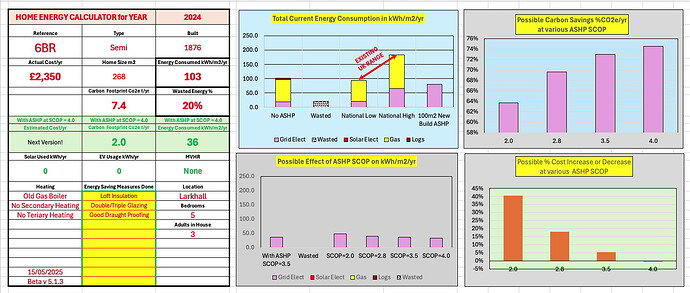New to the forum and I’ve been trying to do as much reading as possible!
I’ve put my house plan into heatpunk and have played around with the air changes, but I don’t know exactly what our air tightness is, and obviously this makes quite a big difference to the heat loss calculations!
I was fairly happy with the idea that a Vaillant Aerotherm+ 7kW would cover out needs, however I’ve really been put off by all of the negative comments about noise in Vaillant Arotherm: excessive noise from compressor. And also the more I read about heat pumps, the more I realise that oversizing will mean that the unit can modulate down as well (leading to more cycling in certain conditions, which is bad).
I have started to wonder if I can get my heat loss low enough to be covered by the 5kW unit (which seems to have much better reviews?), however I have also seen the posts about baking in extra capacity for when the weather is both cold and damp, therefore I don’t want to go too low!
I was wondering if I could use my gas bill from previous cold spells to estimate my max heat loss requirements?
The most extreme gas usage I’ve seen since living in the property is:
18th Jan 2024 (between 0c and -6c outside, 19c inside)
124kWh gas used
85% efficient boiler = 105.4kWh of heat produced (including hot water)
105.4/24 = 4.4kWh average heat demand
Most of this usage is from 7am-11pm, 8kWh being the highest usage period (7-8am), fairly consistent 7kW/h between 9-12, and 6kW/h until 11pm.
So, based on this, would I be able to take the average hourly heat usage figure of 4.4kWh and go with a 5KW unit, or would I need to look at the max usage figure of 7kWh?
This year I have increased the loft insulation from ~150mm to 300mm and I have also been adding 100mm PIR between the floor joists (should be completed before this winter hopefully).
We also have a log burner which we could use in extreme periods.
The heatpunk calculations (when temperature is set to 20c and air changes set to 1) come out as a total heat loss of 5370 W, which is covered by the 5kW unit at 46C flow temperature ( 5676W), however I don’t think heatpunk take into consideration the drop outs caused by the defrost cycles Vaillant maximum output capacity testing.
Would love to hear peoples thoughts on any of this?
